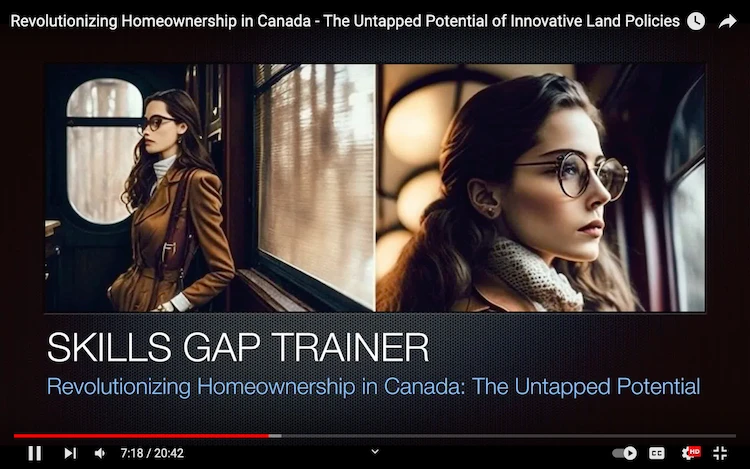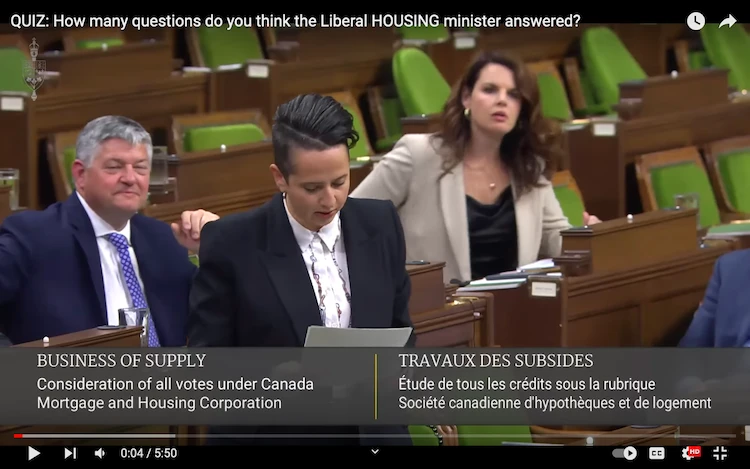Video: Revolutionizing Homeownership in Canada – The Untapped Potential of Innovative Land Policies
YouTube Link: https://youtu.be/nvVb8m8jb2w
Description: This is the video “QUIZ: How many questions do you think the Liberal HOUSING minister answered?” on the YouTube channel of Melissa Lantsman. You will see soon how interesting this is.
Video: QUIZ: How many questions do you think the Liberal HOUSING minister answered?
YouTube Link: https://youtu.be/eGkkSyzRklk
Introduction:
Welcome to a comprehensive exploration of the pressing issue of housing affordability in Canada, presented through an engaging video “QUIZ: How many questions do you think the Liberal HOUSING minister answered?” available on Melissa Lantsman’s YouTube channel, supported by three thought provoking analyses and solutions provided below. This series delves into the complexities of Canada’s housing crisis and potential solutions, such as innovative land policies and gatekeeper regulation reforms.
In our three-part analysis, we dissect critical discussions from a transcript, analyzing the statements of Canadian political figures and experts. We touch upon the debate between the Conservative and Liberal parties on housing policies, the potential impact of the fiat system on housing prices, and the urgent need to address Canada’s housing affordability crisis. These analyses provide a thorough examination of the dialogue, pinpointing patterns of deflection, identifying neglect of crucial aspects like land policy, and highlighting the need for more substantial and clear action plans.
The heart of our “The House Journey” series describing issues related to this video, where Melissa Lantsman’s spirited debate style brings to light the potential solutions to Canada’s approach to the housing issue.
Our three part analysis primarily focuses on the innovative proposal of “printing” land – a concept referring to making more land available for housing construction, potentially through zoning regulation reforms or infrastructure improvements. This proposal stands in stark contrast to “printing” money, which can result in inflation and economic instability, as proposed by the Liberal Housing ministers.
This concept of “printing” land is further elaborated upon in the third part of our analysis. We examine the potential beneficiaries, including new homeowners, existing homeowners, and the broader economy. Our analysis address fears of over-development and environmental damage, as well as the potential impact on housing prices.
In this exploration, we aim to present a nuanced view of the housing crisis in Canada and the possible remedies. By bridging political debates with economic realities and innovative proposals, we present an enriched overview that engages the viewer to think critically about the issue. The video and the analysis serve as complementary resources, each enriching the understanding of the other, ultimately providing an insightful perspective on the housing issue in Canada.
Whether you are new to the issue of housing affordability, a seasoned observer, a policy maker, or someone directly impacted by the housing market, these resources will help you understand the complexities of the problem and potential solutions. We invite you to join us in this journey through the housing crisis in Canada and the exploration of potential ways forward.

Unraveling Canada’s Housing Crisis: A Critical Analysis of Political Debates and Melissa Lantsman’s Tenacious Approach
The issue of housing affordability in Canada is complex, multi-faceted, and requires both innovation and attention to detail. This is a critique of the differing approaches to housing affordability by two key players: Melissa Lantsman, representing the Conservative party, and Ahmed Hussen, the Housing Minister from the Liberal party. We agree with the platform proposed by the Conservative Party. This is our initial and first impression of Melissa, our initial and first impression of the Liberal Housing Minister, and the housing issue in Canada.
Effective Questioning: Lantsman’s questions were direct, clear and focused on facts. She was asking for specific numbers related to the housing market, showing her desire for data-driven discussions.
Persistence: Despite not getting direct answers from the housing minister, Lantsman continued to press with her line of questioning, demonstrating her persistence.
Knowledgeable: Her inquiries indicate a deep understanding of housing issues and the specific challenges faced by Toronto. She understands the details, such as average rent prices and the financial requirements for buying a home.
Strong Communicator: Lantsman displayed her ability to communicate complex ideas effectively. She was able to challenge the minister’s approach and argue her points convincingly. Preparedness: She came prepared with data and statistics to the discussion, which shows her commitment and seriousness towards the issue of housing.
Rational and Logical: Lantsman’s line of questioning was based on logical reasoning. She was trying to establish a correlation between the increase in housing prices and the policies of the current government. Resilience: Despite the minister’s attempts to deflect or avoid her questions, she maintained her composure and continued to push for answers.
Respect for Citizens: She appears to respect Canadian citizens by working diligently to address their housing concerns.
Ambitious and Driven: Lantsman’s fervor, ambition, and drive to challenge the status quo and seek solutions for the housing crisis are evident in her approach.
Melissa demonstrates a comprehensive understanding of the housing issue, strong communication skills, and a persistent desire to question and challenge current policies. We hope Melissa challenges the land out of the Governments tight grip and into our grip. Her approach is data-driven, logical, and innovative, showing a readiness to explore new ideas to address the housing crisis effectively.

Our contribution:
Micro Report Comment: An appreciated comment on housing issues of Canada.
Reminder for Tenacious Struggle For Innovation in Land Policy: From the video, it’s clear that Melissa is open to new ways of thinking. Canada is the second-largest country in the world by land area, following Russia. The economic value of Canada’s land, at current market rates / 7000 square foot lot, is very high if worked out in total sum.

In addition, within a potential landscape of moderate or even hyperinflation, this approach could open up an avenue for the Canadian government to generate trillions of dollars in revenue. All this, would still maintain the status quo of no actual land development required to be done by the government, as all that would be required would be drawing a box on the map of where the lot to be parcelled out should be. This “easy box drawing strategy”, called “zoning”, could offer Canadians a significant land-based hedge during financially challenging times, as well as support organizational development which need space to launch business operations.

It is our proposition that the trailblazing spirit and tenacity of Melissa has a high probability chance of breaking through bureaucratic gatekeepers. This could prove crucial in bringing about the innovative change needed in our land policy. If you do not believe us, would you challenge her in a debate? We certainly wouldn’t. She will crush you like a cheap aluminum tin can before you even have a chance to stand up for debate, just like she crushed this Minister, who on the whole looks like a very respectable and very good critical thinker, certainly would make a much better PM than what Liberal Party has now.

Transparency and Strategy Lacking: An In-depth Dissection of the Liberal Housing Minister’s Approach to Canada’s Housing Crisis
Lack of Direct Answers: Throughout the exchange, the Housing Minister consistently avoids answering direct questions about housing prices, rent rates, and median incomes. For example, when asked about the average rent of a one-bedroom apartment in Toronto in 2015, instead of providing a number, the Minister diverts the question to a critique of the Conservative Party’s approach to housing. This pattern repeats throughout the video. It is a pattern championed by Liberal Party leader.
Deflection to Party Politics: Another noticeable pattern is the Minister’s repeated deflection to party politics. Rather than addressing the questions or providing substantial data, the Housing Minister often resorts to criticizing the opposition’s stance on housing policy. This can be seen as an attempt to divert attention away from the issues at hand. But in fact Pierre did in several commercial videos mention land policy, address the vast potential of land in Canada as available for Canadians, that is the implication, and did mention it in interviews as well. Pierre addressed gatekeeper regulation or unbundling as well, fixing yet another point on the roadblock home ownership in Canada. And third, Pierre suggested a responsible industrial and technological development plan, that would provide the necessary capital to people to build the material aspect of the house, if not the whole thing.
Lack of Concrete Plan: Based on this transcript, it appears that the Housing Minister doesn’t present a clear, concrete plan for addressing housing issues. Instead, he refers to past actions, such as the introduction of the Canada housing benefit, without providing clear future actions or strategies. This may give the impression of a lack of foresight or strategic planning.
Focus on Subsidies: The Liberal party’s approach, represented by Hussen, largely revolves around subsidies and welfare. However, such an approach may only serve to fuel housing inflation, rather than mitigating it.
Potential Fiat System Issues: The underlying economic system can also play a role in housing affordability. In a fiat system, where money is not backed by a physical commodity like gold, governments have the ability to control the money supply. If not managed carefully, this can lead to inflation, which in turn can contribute to rising housing prices.
Affordability Crisis: There is a significant affordability issue at play. Melissa Lantsman suggests that many families are be priced out of the housing market.
Lack of Focus on Supply: The Housing Minister mentions that one of the solutions to higher housing prices is more supply. However, based on the video, there seems to be a lack of focus on tangible actions or policies to increase housing supply, which can be a key factor in easing housing prices.
Neglect of “Land Policy”: Hussen does not seem to focus on land policy as a potential solution to housing affordability. This might be a missed opportunity, as innovative land policies could unlock significant value and address housing affordability more holistically.
Neglect of “Gatekeeper Regulation Policy”: Indeed, the issue of “gatekeepers” is another crucial aspect of the housing problem that needs to be addressed. By “gatekeepers,” we refer to the various entities and processes involved in housing construction that can add significant cost and time to the process. These can include zoning regulations, building codes, permit requirements, inspection processes, and more. In some cases, these can add up to a significant portion of the total cost of a new home. For instance, in Vancouver, administrative costs can add an estimated $600,000 to the construction of a house.
In conclusion, the conversation highlights a need for clearer, more direct communication from the Housing Minister, a focus on concrete action steps rather than party politics, and potentially a review of economic policies that could be contributing to rising housing prices, via a review of the actions of Liberal Party leader. Furthermore, it underscores the urgent need to address the affordability crisis in the Canadian housing market.

Bridging the Home-ownership Gap: The Promise of Innovative Land Policies
New Homeowners: The most direct beneficiaries of innovative land policies would be potential new homeowners, particularly those who have the financial means for construction but are priced out by land costs. This could include millennials, Generation Z individuals, and newcomers to Canada. By effectively “printing” land, the government could supply these potential homeowners with the necessary land to construct their homes, thereby lowering the barrier to homeownership.
Existing Homeowners: Existing homeowners could also stand to benefit from these policies. By increasing the supply of land for housing, these policies could stabilize housing prices, thereby reducing the risk of a housing market crash that could potentially wipe out a homeowner’s life savings, or the potential risk of hyperinflation or revolution, that would result in the confiscation or destruction of the home owner’s property. (Note: The book “When Money Dies”, may be a good reference for all of us to investigate, as a precautionary tale to take seriously the land printing thesis proposal.)
1/ Historical Perspective: Historically, homeowners, observing the rapid appreciation of their homes, are tempted to maintain the status quo and resist government action to print land. However, this strategy has historically led to hyperinflation, where the purchasing power of the homeowners’ life savings were lost, along with their homes. This scenario has even been a catalyst for global wars. Implementing policies to increase land availability could help avoid such devastating outcomes by stabilizing housing prices and reducing the risk of rising inflation or hyperinflation.
2/ New Opportunities: The availability of surplus land could yield new business and house buying opportunities even for existing homeowners. This would allow for growth in a decentralized and more resilient manner, compared to the high-risk strategy of relying solely on the value of one’s primary residence. With more land available, homeowners could diversify their investments, spreading the risk and potentially reaping the rewards of other opportunities.
3/ Inflation Control: Slowing down housing inflation may reduce the overall need and urgency for the government to inject more capital into the economy as a reactionary measure to crisis. This could potentially reduce the inflation level within the entire economy, protecting the purchasing power of the homeowner’s income and resulting in significant savings over their lifetime. Additionally, it could safeguard the value of the homeowner’s overall savings portfolio, including pensions, and protect the purchasing power of the income of the homeowner’s children, grandparents, and other relatives.
The Economy: A more stable housing market could lead to a healthier economy. With homeownership more attainable, more people might be able to invest in housing, spurring economic growth. Moreover, the construction industry would likely see a boost, leading to job creation and economic stimulation. Further, new business starts would start to happen, as organization are able to access inaccessible land currently required to launch or expand operations.
Government: On a macro level, the government could potentially benefit from the increased economic activity that comes with an increase in construction, homeownership and increased business ownership. This could lead to higher tax revenues without having to increase tax rates.

Contrasting “Printing” Land with “Printing” Capital:
When a government “prints” more money, it can lead to inflation, which can erode purchasing power and create economic instability. Conversely, “printing” land – in other words, making more land available for housing construction – could have the opposite effect on housing prices. This is because the cost of housing is largely determined by the supply of and demand for land. By increasing the supply of land, housing prices could be stabilized or even reduced.
However, it’s important to note that while land is a finite resource, its value can be influenced by zoning regulations, infrastructure, and other factors. Therefore, the government could “print” land value by changing zoning regulations, improving infrastructure, or implementing other policies that increase the value or usability of land.
Addressing Fears:
Some might fear that increasing the supply of land could lead to overdevelopment or environmental damage. However, these risks could be mitigated with careful planning and regulation. For example, the government could enforce regulations that require sustainable building practices, or it could prioritize the development of lands that have been previously used or that are less environmentally sensitive.
Others might worry that this approach could lead to a decrease in housing prices, negatively impacting existing homeowners. While it’s true that an increase in land supply could stabilize or even decrease housing prices, the inflation rate on houses in Canada is not 1% or 2% in line with the desired growth of currency supply, but at times has gone upwards of 35%, a problem which could be balanced by the fact that more people would be able to afford homeownership, increasing overall demand. Moreover, a more stable housing market could reduce the risk of a housing market crash, which would benefit all homeowners.
Further with more lots available, for rent by public, lease by public, or purchase by public, in combination with the removal of gatekeepers, the Government could earn another source of tax revenue that would replace current taxation levels, as happens in many southeast Asian countries that are highly successful.
In conclusion, while any major policy change involves risks, the potential benefits of innovative land policies – including more affordable housing, a more stable housing market, and economic growth – could outweigh the potential downsides. By communicating clearly about these benefits and addressing fears and concerns proactively, leaders could build public support for these innovative policies.
Note: Our first impression is that Melissa debate style, is reminiscent of a character worthy of Star Trek. Melissa is demonstrating qualities of a Starfleet Command Officer. She reminds us of Kira, with her fire and investigative abilities, but succums to none of Kira’s emotional vulnerabilities. In fact, Melissa transcends Kira, with the accuracy and analysis of Dax as well, denoted by the uniform in blue. Kira Dax, your YouTube channel will do well.
Related Content:
YouTube Clip: Why Homes in Canada are so Expensive – The Human Story
@skillsgaptrainer “Having watched this video and after a discussion with our team, a few interesting points stand out. Firstly, the video underscores the concerning trend where local councils might be influenced by or led by homeowners to maintain single-family zoning, leading to a lack of housing diversity. It’s just so amazing how few new townhouse complexes, apartment complexes, duplexes, triplexes, fourplexes, strata lots there are in suburb areas, not just in the downtown core, anywhere in Canada. Perhaps Alberta (Edmonton, Calgary) and Quebec do things differently, and that might explain their higher affordability levels. This tactic, of preventing every type of zoning except “freehold single family detached” in the suburban areas, intentional or not, would naturally drive up housing prices due to limited supply, especially with the recent surge in immigration beyond the historical norms.
It’s also alarming to note that while our population has doubled since 1976, we’ve only increased our housing starts by a mere 16% since the 1976. The disparity here is absolutely massive and raises questions about the government’s approach, over the past few decades, but especially during Trudeau’s tenure from 2015-2023, as he increased the disparity further via the alteration of the immigration levels. Is the government really balancing long-term economic goals effectively with the immediate housing needs of its people, particularly immigrants, Gen Z, or the millennials without access to a housing inheritance.
We’ve heard often from immigrants or younger demographics about the “sentiment” or “theory of a national covenant”, rightly or wrongly, that the government, which houses representatives from older generations, and some newer employees from Gen X and a few millenials raised in “house owner communities”, also known as “house people”, have been making decisions that favour the overall economy on a long term basis, at the expense of immediate housing affordability for younger demographics or immigrant demographics. While a robust economy is essential, it’s hard not to feel like these decisions, such as a federal government seeking more immigrants for economic growth/tax growth, is something that the older generations desire, but again, it dis-proportionally impacts the younger demographics or immigrants in Canada who try to secure their first homes or their first few jobs.
Further, the video argues that the immigration to Canada is not for the needed trades workers or blue collar workers, that are needed to build infrastructure, clean energy systems or homes, but that the immigration is in fact for white collar workers, something that every Canadian millenial and Gen Z is already labelled as, as most millenials have received between 5 to 30 years of training in post-secondary. Most millenials and soon too Gen Z will also be educated to at least to the diploma, bachelor, master or doctorate level.
The potential implications for social cohesion and perceived disparities between generations are significant and need a thorough examination. If a part of the population is attempting to skew the home prices, we believe the social and economic consequences could be significantly underestimated, and that it will not be a positive for Canada once the consequences are revealed.
This video and our discussions have only reinforced the importance of continuing this dialogue, holding our policymakers accountable, and ensuring a future where everyone can afford to buy a home.“
Related books and resources:
“The Affordable City: Strategies for Putting Housing Within Reach (and Keeping it There)” by Shane Phillips – This book tackles the issue of housing affordability and offers a multitude of strategies that cities can use to address this growing concern. It’s well-reviewed and provides a comprehensive look at land use, rent control, and affordable housing development.
“Evicted: Poverty and Profit in the American City” by Matthew Desmond – While this book focuses on the United States, the profound stories and data-driven insights provide a valuable perspective that can be applied to the Canadian context, especially regarding the human impact of housing policies and economic systems.
“Generation Priced Out: Who Gets to Live in the New Urban America” by Randy Shaw – Shaw’s analysis on who gets to live in cities where housing has become prohibitively expensive is pertinent to Canadian cities facing similar issues. This book discusses zoning, politics, and what cities can do to keep housing affordable.
“The Death and Life of Great American Cities” by Jane Jacobs – A classic in urban planning literature, Jacobs’ observations and arguments for creating vibrant, livable cities can inform modern housing policy, especially when considering the balance between development and community needs.
“Cities for People, Not for Profit: Critical Urban Theory and the Right to the City” edited by Neil Brenner, Peter Marcuse, and Margit Mayer – This collection provides a critical look at urban development and housing, touching on the role of profit in city planning and the importance of housing as a human right.
“Capital City: Gentrification and the Real Estate State” by Samuel Stein – Stein’s book delves into the role of urban planning in the age of real estate dominance, with insights applicable to understanding the Canadian housing market and the forces at play.
“Homelessness in Canada: Understanding the Challenge and Finding Solutions” by John Howard Society of Canada – This report gives a comprehensive overview of homelessness in Canada, an extreme consequence of the housing crisis. It’s vital for understanding the stakes of housing policy and land use reforms.
“The Public Wealth of Cities: How to Unlock Hidden Assets to Boost Growth and Prosperity” by Dag Detter and Stefan Fölster – While not exclusively about Canada, this book explores how cities around the world can manage their assets, including land, to improve public wealth and infrastructure. It provides a global perspective that could be applied to Canadian contexts, especially regarding Crown lands and urban development.
“Land Use Planning Made Plain” by Hok-Lin Leung – This is an accessible guide to land use planning that explains key concepts, processes, and terminology. While it’s not Canada-specific, the principles and practices can be applied to the Canadian context, especially in understanding zoning laws and land use for housing solutions.
“Canadian Land Law” by Anne Warner La Forest – This book provides an overview of legal principles governing land use in Canada, including aspects related to Crown land, property rights, and zoning regulations. It’s essential for understanding the legal framework within which Canadian housing policies operate.
“Affordable Housing in Canada: Evolving Dialogue, Frameworks and Projects” edited by Julia Christensen and Joshuah T. Jelly-Schapiro – This collection explores different perspectives on affordable housing in Canada, including policy approaches, community initiatives, and the role of land use regulation. It provides valuable insights into addressing housing challenges in Canada.
“Urban Planning for Dummies” by Jordan Yin, W. Paul Farmer – Although not Canada-specific, this book offers an easy-to-understand introduction to the field of urban planning, including topics such as zoning, land use, and community development. These concepts are vital for addressing housing issues in Canadian cities.
“The Canadian Regime: An Introduction to Parliamentary Government in Canada” by Patrick Malcolmson, Richard Myers, and Gerald Baier – This book provides an understanding of Canada’s governmental structure, including how land policies and housing regulations are formulated and implemented, which is crucial for understanding Crown land management.
“Housing the North American City” by Michael N. Danielson and Jameson W. Doig – This book compares housing policies and development in Canadian and American cities, providing historical context and exploring issues like zoning and public land use, relevant to understanding Canada’s housing challenges.
“Planning Canadian Regions” by Gerald Hodge and Ira M. Robinson – This textbook covers regional planning theories and practices in Canada, including land use strategies, environmental concerns, and urban development. It offers perspectives on managing Crown lands and zoning for better housing solutions.
“Unbuilt Toronto: A History of the City That Might Have Been” by Mark Osbaldeston – While focusing on unbuilt projects, this book offers insights into land use decisions, zoning, and urban planning in Toronto. It provides context for current housing challenges and the role of public land.
“The Value of Land: Planning and Development in the Urban Economy” by Thomas L. Daniels and John W. Keller – This book discusses the economic aspects of land use and planning, relevant for understanding how Crown land can be utilized to address Canada’s housing affordability issues. While it is more U.S.-focused, the economic principles are applicable to the Canadian context.
To see our Donate Page, click https://skillsgaptrainer.com/donate
To see our Instagram Channel, click https://www.instagram.com/skillsgaptrainer/
To see some of our Udemy Courses, click SGT Udemy Page
To see our YouTube Channel, click https://www.youtube.com/@skillsgaptrainer


